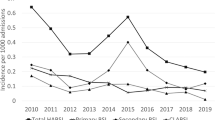Abstract
Objective:
To determine the association of a central-line maintenance team on the incidence of central-line-associated bloodstream infections (CLABSIs) in the neonatal intensive care unit (NICU).
Study Design:
Central line maintenance in the NICU was limited to a line team starting in March 2008. CLABSI rates were determined before (December 2006 to February 2008) and after implementation of the line team ( March 2008 to August 2010) utilizing consistent National Healthcare Safety Network definitions. Rates were calculated by birth weight categories and overall. Data analysis was performed by two-proportion t test using Minitab.
Result:
Overall CLABSI decreased by 65% after implementation of the line team. Pre intervention, mean overall CLABSI rate was 11.6 /1000, as compared with 4.0/1000 after intervention (P<0.001). Birth-weight-specific CLABSI rates also decreased significantly. Decreased infection rates were sustained over time.
Conclusion:
A line team provided for standardized, consistent central-line maintenance care leading to a significant, sustained decrease in CLABSI in a NICU.
This is a preview of subscription content, access via your institution
Access options
Subscribe to this journal
Receive 12 print issues and online access
$259.00 per year
only $21.58 per issue
Buy this article
- Purchase on Springer Link
- Instant access to full article PDF
Prices may be subject to local taxes which are calculated during checkout



Similar content being viewed by others
References
Marschall J, Mermel LA, Classen D, Arias KM, Podgorny K, Anderson DJ et al. Strategies to prevent central line-associated bloodstream infections in acute care hospitals. Infect Control Hosp Epidemiol 2008; 29: 522–530.
Couto RC, Pedrosa TM, Tofani C, Pedroso ER . Risk factors for nosocomial infection in a neonatal intensive care unit. Infect Control Hosp Epidemiol 2006; 27: 571–575.
O’Grady NP, Alexander M, Burns LA, Dellinger P, Garland J, Heard SO et al. Guidelines for the prevention of intravascular catheter-related infections. Clin Infect Dis 2011; 52: e162–e193.
Provonost P, Needham D, Bernholtz S, Sinopoli D, Chu H, Cosgrove S et al. An Intervention to decrease catheter-related bloodstream infections in the ICU. NEJM 2006; 355 (26): 2725–2732.
Costello JM, Morrow DF, Graham DA, Potter-Byone G, Sandora TJ, Laussen PC . Systematic intervention to reduce central line-associated bloodstream infection rates in a pediatric cardiac intensive care unit. Pediatrics 2008; 121 (5): 915–923.
Miller MR, Griswold MJ, Harris M, Yenokyan GW, Huskins C, Moss M et al. Decreasing PICU catheter-associated bloodstream infections: NACHRI's Quality transformation efforts. Pediatrics 2010; 125 (2): 206–213.
Schulman J, Stricof R, Stevens TP, Horgan M, Gase K, Holzman IR et al. Statewide NICU central-line-associated bloodstream infection rates decline after bundles and checklists. Pediatrics 2011; 127 (3): 436–444.
Kaplan HC, Lannon C, Walsh MC, Donovan EF . Ohio statewide quality-improvement collaborative to reduce late-onset sepsis in preterm infants. Pediatrics 2011; 127 (3): 427–435.
Wirtschafter DD, Powers RJ, Pettit JS, Lee HC, Boscardin WJ, Subeh MA et al. Nosocomial infection reduction in VLBW infants with a statewide quality-improvement model. Pediatrics 2011; 127 (3): 419–426.
Curry S, Honeycutt M, Goins G, Giliam C . Catheter-associated bloodstream infections in the NICU: getting to zero. Neonatal Network 2009; 28 (3): 151–155.
Soifer NE, Borzak S, Edlin BR, Weinstein RA . Prevention of peripheral venous catheter complications with an intravenous therapy team. Arch Intern Med 1998; 158: 473–477.
Meier PA, Fredrickson M, Catney M, Nettleman MD . Impact of a dedicated intravenous therapy team on nosocomial bloodstream infection rates. Am J Infect Control 1998; 26: 388–392.
Miller JM, Goetz AM, Squier C, Muder RR . Reduction in nosocomial intravenous device-related bacteremias after institution of an intravenous therapy team. J Intra Nurs 1996; 19: 103–106.
Brunelle D . Impact of a dedicated infusion therapy team on the reduction of catheter-related nosocomial infections. J Infus Nurs 2003; 26: 362–366.
Horan TC, Gaynes RP . Surveillance of nosocomial infections. Misc: In: Mayhall CG (ed). Hospital Epidemiology and Infection Control, 3rd edn. Lippincott Williams & Wilkins: Philadelphia, 2004, pp 1659–1702.
Horan TC, Andrus M, Dudeck MA . CDC/NHSN Surveillance definitions of healthcare associated infection and criteria for specific types of infections in the acute care setting. Am J Infect Control 2008; 36: 309–332.
Edwards JR, Peterson KD, Banerjee S, Allen-Bridson K, Morrell G, Dudeck MA et al. National healthcare safety network (NHSN) report: data summary for 2006 through 2008, issued december 2009. Am J Infect Control 2009; 37: 783–805.
Lee TW, Ko YK . Effects of self-efficacy, affectivity and collective efficacy on nursing performance of hospital nurses. J Advan Nurs 2010; 66: 839–848.
Robert J, Fridkin SK, Blumberg HM, Anderson B, White N, Ray SM et al. The Influence of the composition of the nursing staff on primary bloodstream infection rates in a surgical intensive care unit. Infect Control Hosp Epidemiol 2000; 21: 12–17.
Acknowledgements
We would like to acknowledge Kathy Masters MSRD, Kathy Luther RN, MPM and Amit Pazgal, PhD for their assistance in data analysis.
Author information
Authors and Affiliations
Corresponding author
Ethics declarations
Competing interests
The authors declare no conflict of interest.
Additional information
Presented in Part at the Society for Healthcare Epidemiology of America National Conference, 2009.
Rights and permissions
About this article
Cite this article
Holzmann-Pazgal, G., Kubanda, A., Davis, K. et al. Utilizing a line maintenance team to reduce central-line-associated bloodstream infections in a neonatal intensive care unit. J Perinatol 32, 281–286 (2012). https://doi.org/10.1038/jp.2011.91
Received:
Revised:
Accepted:
Published:
Issue Date:
DOI: https://doi.org/10.1038/jp.2011.91
Keywords
This article is cited by
-
Current training in percutaneously inserted central catheter (PICC) placement and maintenance for neonatal–perinatal medicine fellows
Journal of Perinatology (2020)
-
Prävention von Gefäßkatheter-assoziierten Infektionen bei Früh- und Neugeborenen
Bundesgesundheitsblatt - Gesundheitsforschung - Gesundheitsschutz (2018)
-
Letter regarding ‘Utilizing a line maintenance team to reduce central-line-associated bloodstream infections in a neonatal intensive care unit’
Journal of Perinatology (2013)
-
Reply: Utilizing a line maintenance team to reduce central-line-associated bloodstream infections in a neonatal intensive care unit
Journal of Perinatology (2013)



